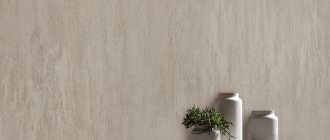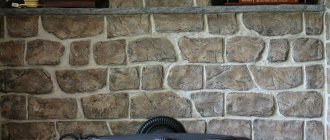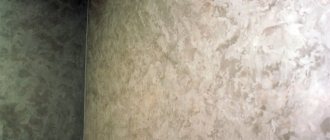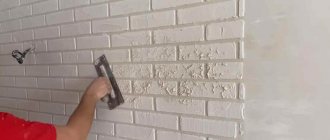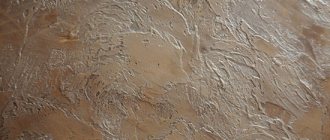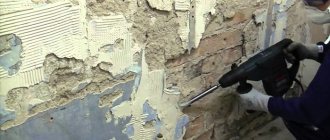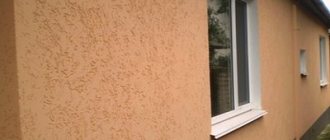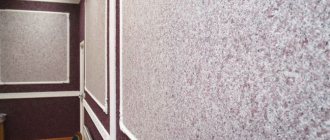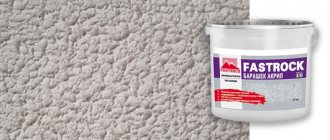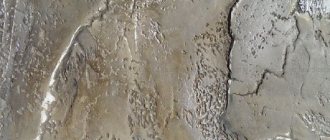Decorative brick-like plaster is very popular during renovation and decoration of premises in residential buildings. This solution allows you to create an imitation of brickwork inside the rooms, and the method of creating such decor is quite simple. Today in the article we will talk about how to choose a method for creating decorative plaster, and also consider the key features of this interior design option.
Advantages and features of brick imitation plaster
Any type of decorative coating has its own distinctive features and advantages. Imitation of brickwork has the following advantages:
- It is quite easy to create a brick imitation with your own hands, so it is possible to save money on the work.
- Decorative bricks have increased strength; such a coating will reduce the degree of wear and tear on the walls.
- Brickwork weighs quite a lot, but decorative imitation has little weight.
- The use of decorative coating is suitable not only for decorating the facade of a building, but also for interior decoration of room walls.
Pros and cons of finishing
Let us list the main advantages of such coatings:
- unlike bare stone walls, up close the surface looks very neat and even elegant;
- small thickness: the space of the premises does not decrease after finishing, because to obtain voluminous bricks a plaster layer of 10-30 cm is sufficient;
- minimum weight: it is much less than that of natural brickwork; Even old houses with wooden floor beams can be finished with such plaster;
- the ability to imitate any type of brick or stone;
- less work required than when laying brick walls;
- high strength of surfaces: when using high-quality mixtures, they do not crack or wear out;
- When using polymer-based coatings, the walls can be easily wiped or washed with a regular rag.
Flaws:
- the need for preliminary surface preparation: cleaning of old plaster and paint, as well as leveling;
- any textured surfaces collect dust faster, so such walls need periodic cleaning;
- the ability to work with solutions only at positive temperatures.
Tips and tricks before coating
Before you begin work on creating a decorative plaster coating, you should prepare. To do this, it is recommended to watch training videos, as well as prepare all the tools and materials in advance. For convenience, we recommend using our selection tips:
- For indoor use, you should choose an environmentally friendly composition.
- In buildings with high humidity, it is recommended to use moisture-resistant materials with antifungal coating.
- It is better to create a facade from mixtures with increased strength.
- It is better to choose a quality option, even if it is more expensive.
- The color scheme should fit harmoniously into the interior.
Using a spatula, brush or broom you can create texture on the bricks
What tools will you need?
Any work begins with the preparation of tools and materials with which the room will be decorated. In this case, you will need to purchase the following set:
- A solution suitable for a specific type of wall to create an imitation of brickwork.
- A container for preparing the mixture, as well as a construction mixer for mixing the material.
- Several spatulas of various shapes and sizes for applying the material.
- To level the coating you will need a level.
- To create seams, prepare masking tape or string.
- If you want to add color, you should purchase color or paint.
Depending on the chosen method of work and type of material, the set of tools may differ slightly; select those tools that will be convenient for you to work with.
You can use brushes or rollers instead of a spatula, and use adhesive tape instead of tape. It is also worth providing yourself with personal protective equipment so as not to get dirty while decorating.
Selecting a material to create an imitation
The range of materials for creating decorative coverings is limited only by the imagination of the residents, but there are several tips for choosing the right one. You can purchase a regular mixture or a composition with additional properties that increase the strength of the coating and its resistance to mechanical damage.
Bricks made from ordinary putty
The simplest version of the mixture from which an imitation of brick is created is ordinary acrylic putty in combination with sand. This composition will ensure the strength and good adhesion of the coating used. If desired, you can purchase a mixture based on silicate and silicone polymers, which provide antifungal properties and increased moisture resistance of the material.
Gypsum plaster bricks
If you want to create an imitation of white bricks, you should purchase a gypsum-based mixture. The key criterion for choosing a material in this case is good adhesion (adhesion strength to the surface), so you should not buy the cheapest version of the mixture. If desired, plaster can be painted in any color using a painter, and its structure can also be changed using a spatula and stencils.
Application of rusticated plaster
Previously, there was a fashion to decorate buildings with large stones in the form of masonry with rustications (seams between individual elements), but over time, such design lost its relevance. Now special types of rusticated plaster are used, which are applied to the facade of a building to create an imitation of stone or brick. At the same time, the wall seems more massive and majestic, so this design is suitable for large houses and large buildings.
Preparing the wall for work
In order for the decorative brick plaster to lay evenly on the wall, you should prepare the surface in advance; for this you need to perform the following manipulations:
- It is necessary to remove the old layer of coating, and you should completely get rid of wallpaper, paint and decorative elements.
- Using sandpaper you can clean the surface.
- To ensure that the future brick layer stays securely on the wall, the coating should be treated with a primer.
- A layer of plaster will hide some surface imperfections, but it is better to repair large chips and cracks before decorating.
Sequence of work
Plaster shingles.
- After fixing the mesh over the entire area of the façade of the house, guide profiles of the beacons are installed. They are attached strictly vertically along a plumb line and horizontally along a water level on alabaster. The distance between the profiles is slightly less than the length of the plaster rule.
- Internal and external metal corners are installed on all window and door openings. They will also protect against cracks in the plaster.
- A thin layer of very liquid plaster is applied to the walls, the method is called spraying.
- Next, the plaster is thrown between the beacons, creating a layer of soil. The layer can be thick, so the material should have a thick consistency.
- After the plaster has dried a little, after 20 minutes, the rule is to move it from top to bottom along the metal beacons, smoothing out any unevenness. The resulting holes in the surface of the coating are again filled with solution. Again they follow the rule. And so on as many times as needed until the surface becomes smooth, without holes or ruts.
It is necessary to plaster the facade in dry weather: even if it rains in summer, water will wash away the damp plaster very quickly, and heavy rain can remove it right down to the brick.
To avoid cracks, do not plaster at sub-zero air temperatures.
How to make a drawing of brickwork
There are several technologies and methods for creating imitation brickwork. The choice of the method used depends on the interior of the building, the design of the walls, as well as their strength. In addition, the creation of a pattern depends on what size (meaning the size of the bricks) you choose for decoration.
You can apply the material in any convenient way, but you should take into account the size of the masonry so that it matches the actual size of the bricks.
Wall marking
In order for the decoration to be successful, the wall is initially marked. For marking, a level or rule is used; with its help, lines parallel to the floor are drawn. After this, vertical lines are drawn. It is important to follow three rules:
- The brick size is 250 by 65 mm.
- The thickness of the seams between individual bricks is 10 mm.
- The bricks in the top layer should move relative to the bottom layer.
The final appearance of the wall and the similarity of the coating to real brick will depend on how correctly the markings are chosen. Various methods can be used to perform marking and application.
Imitating a wall, using masking tape to create a grid
The imitation brickwork is formed with ordinary masking tape; adhesive tape can also be used instead. Tape is applied to the pre-prepared wall along the marking lines. Then the coating is applied; it is enough to use a layer 4-6 mm thick. When the entire surface is covered with decorative plaster, you need to peel off the tape. At the places where it is attached there will be lines corresponding to the masonry seams.
Drawing seams with a scraper
A mesh that imitates seams from the joints of bricks is excellent when working with scrapers. To do this, you need to prepare the lines on the wall, check with a level that the lines are drawn correctly, and then apply the plaster to the wall. After this, use a scraper to remove part of the mortar in the places where the seams should be.
Using a stencil
For convenience, special stencils are used to imitate brickwork. Initially, a layer no more than 5 mm thick is applied to the wall. After this, the stencil is moistened with a small amount of water and applied to the wall. After a few seconds, the stencil is smoothly removed, after which the procedure is repeated (this time the stencil is deepened into the wall to create a grid). After removing the stencil, the finishing is done and the wall is covered with paint and varnish.
Formation of individual bricks
Brick plaster can be made by cutting bricks into the mixture:
- When using this method, it is necessary to apply the material evenly (5 mm thick) to the wall.
- A grid with markings should be placed on top of the applied mortar to form bricks.
- After the mixture has dried, use a narrow chisel or scraper to remove the material from the places where the seams should be.
- If desired, you can create bricks along the entire wall, or you can leave some areas intact to create the effect of unfinished brickwork.
- The material must be removed using a level to create an even mesh. Sandpaper is used to remove excess coating and smooth corners.
Using a special roller
The formation of a decorative pattern is easily carried out using a special roller. The material that is applied to the wall should be moistened with a small amount of water from a spray bottle before creating seams. In addition, each subsequent layer must be shifted relative to the previous level.
Making a roller at home + video
It is quite easy to make a roller for decorative plaster with your own hands; the manufacturing process consists of several simple steps:
- Remove the upper part (lining) from the roller, leaving only the main cylinder.
- The surface of the roller must be covered with a layer of sealant. After applying the sealant, use your fingers dipped in soapy water to remove any uneven surfaces.
- On top of the first layer, it is necessary to apply strips of sealant around the axis of the cylinder. One strip should be outlined in the middle and two more should be applied along the edges of the cylinder.
- Then between the resulting rings it is also necessary to draw lines of sealant. One line is drawn between the left and central rings along the axis, the other line is drawn diametrically opposite between the central and right rings.
- After the material has dried, the roller can be used for its intended purpose.
How to paint brick trim
The color of the final paint is selected according to the design of the room. The wall can be white, have a color palette close to natural, or it can have bright, unexpected tones. Most often they resort to mixed dyes containing gray, reddish, red-orange and brown shades.
Alkyd, latex or acrylic compounds are used for painting. You can also use water emulsion. For the finishing coat, acrylic matte varnish is used.
Brick plaster has become a very popular solution for interior decoration in modern homes. The ease of implementation and variety of options allow even beginners to get the job done.
Finishing
At the final stage, the finishing of the walls is carried out, which consists of the following points:
- When the coating has dried, sand the edges of the bricks using sandpaper.
- Dust generated during sanding can be removed with a brush.
- After this, they begin to paint the coating, decorating is carried out in any way you like.
- An additional decoration that imitates real bricks can be the addition of chips and small cracks in the coating.
- The final stage of finishing is to coat the wall with varnish to increase the moisture resistance of the material.
How to technologically plaster a house
Ideally, a team of professional builders, those with special educational institutions and long-term experience, will be able to properly and efficiently plaster a brick house. But since you take on this work yourself, it is important to know the sequence of manipulations:
Scheme of plastering walls.
- It is necessary to prepare the facade of the house: remove dirt, unstitch seams.
- Next, prime the walls, that is, treat them with a special compound on which the plaster adheres better.
- It is necessary to reinforce the walls. For this, a regular facade mesh is used, which is nailed to the brick.
- Then beacons are installed - metal strips along which the surface is subsequently leveled.
- After this, the plaster solution itself is applied.
- And the last thing is grout.
Building codes suggest installing a mesh before starting plastering only if the thickness of the mesh is more than 3 cm. However, it makes sense to use it in any situation. It will prevent cracks from appearing on the facade and improve adhesion between the brick and plaster.
Check the verticality of the wall before starting work.
It is imperative to use a mesh when plastering the basement of a building. This part is usually made of concrete, so reinforcement is necessary.
To carry out facade work you will need the following tool:
Painting plaster bricks
The painting process is also a creative process, but there is a certain algorithm of actions:
- Initially, you need to cover the entire wall with one continuous layer of paint.
- After the first layer has dried, use a brush to paint the bricks separately. Using a thin brush, draw the seams between the artificial masonry bricks. To make the applied mixture more reminiscent of brick, it is worth using red shades; in addition, you can create differences in color between decorative elements.
- At the final stage, a varnish to fix and increase the moisture resistance of the coating is applied over the final layer of paint.
How much will decoration cost?
If you want to make a decoration with imitation brickwork with your own hands, you will probably be interested to know about the cost of this idea.
Since the main cost will be plaster, you should calculate the approximate cost of the material that will be needed to cover the wall. The average cost of a pack weighing 30 kg is 400-500 rubles (good quality material), while the consumption will be approximately 5 kg per 1 square meter. In this case, it is easy to calculate the cost of purchasing the material. Additionally, it is worth adding the cost of purchasing other materials and tools (roller, spatula, tape...).
Types of facade plaster
As mentioned above, plaster can be of several types:
Wall pie.
- Mineral. It is the most common due to its low cost. Well suited for plastering brick and concrete. However, it is unstable and short-lived. The color range is very narrow, so this plaster has to be painted.
In general, all facade plasters have certain advantages and disadvantages, therefore, before starting to carry out facade work, consult with experienced builders. They will tell you which plaster will work best on brick, which on concrete, which on insulation. At the same time, rely on your financial capabilities, because facade work has always been quite expensive.
Brickwork in a modern interior
The pattern created by using decorative bricks fits harmoniously into almost any interior. Decorative brick will decorate the design of the kitchen and living room, creating a cozy and unusual atmosphere of warmth in the house. For clarity, we suggest looking at photos of successful wall decoration options.
Tyutyunnikov Dmitry
Article verified by a decorative finishing specialist
